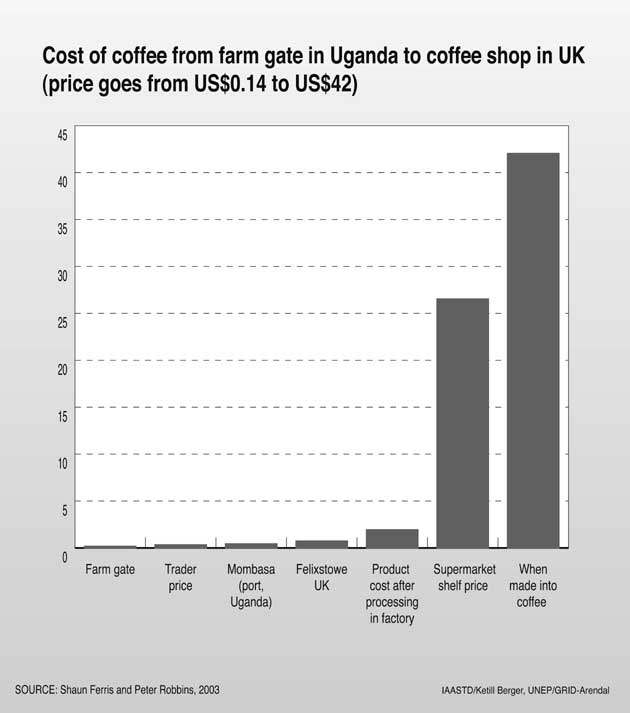
Figure 7-7.Cost of coffee between Uganda production and UK retail. Source: Ferris and Robbins, 2003
nisms should be investigated, market by market, to determine their potential to do this. One critical policy issues is whether the objective should be price stabilization or price increases (Lines, 2006). To address the continued slide in global commodity prices an increasing number of development groups and policy analysts are suggesting that supply management can provide a viable means of dealing with this chronic problem. In the OECD supply management is used to regulate the supply and demand of more than 50 goods on the world market.
7.2.4.3 Escalating tariffs
Current tariff structure is a disincentive for investment in the creation of value-added agroprocessing in the developing south, because developed countries use escalating tariffs. Escalating tariffs discourage development by placing higher tariffs on manufactured goods than on raw commodities and materials. Levying much higher tariffs on processed agricultural products than raw commodities makes it more difficult for developing countries to promote and gain from value-added local agroprocessing industries, which could provide much needed off-farm rural employment (Wise, 2004). Reducing or eliminating tariff escalation would greatly facilitate off-farm diversification in developing countries (Koning et al., 2004) and encourage valueadded agroprocessing (Stiglitz, 2006).
The fisheries sector in many of the poorest countries face trade barriers to diversifying production and exports towards value-added processing products. These barriers include tariff escalation, stringent standards, and rules of origin requirements, among others (ITCSD, 2006). Ne-
gotiations on regulating fisheries subsidies have attracted considerable attention at the WTO, but other areas that are critical to the fisheries sector, including market access, non-tariff barriers, and measures taken under multilateral environmental agreements, have not been addressed. Many stakeholders in the debate, foremost among them the fishing communities whose livelihoods are at stake, have been marginalized in these discussions (ITCSD, 2006).
7.2.5 Options to increase market size, competition, and value capture in commodity chains to increase incomes for small-scale farm sector
7.2.5.1 Regional integration
Regional integration to create larger, regional markets with common external tariffs but no restrictions to internal trade, as a substitute for lack of a large domestic market, can help maintain more consistent demand and stable, higher prices, for locally produced commodities. Large domestic internal markets have often been found to be a prerequisite to agriculture based growth in Asian economies, since they facilitated the shifting of the commodity from surplus to deficit areas, helping to ensure effective demand was maintained even in times of surplus and therefore assisting in stabilizing prices (Morris and Sarris, 2007).
Supporting food production encourages local and regional market integration. In many low income countries especially in Africa, emphasis on cash crop production for export has encouraged transportation networks linking rural areas direct to ports bud neglecting internal connections such as local market feeder roads that would benefit small scale farmers producing for local and regional markets. Greater emphasis on food production for local markets reduces the need for domestic farmers to contract as suppliers to multinationals and encourages greater independence. While some producers will continue to find it profitable to link into global commodity chains, regional integration can create the opportunity for small scale producers to diversity their markets with potentially significant benefits for rural livelihoods (Morrisey, 2007).
7.2.5.2 State trading enterprises for developing country export commodities
Many observers note that that in many marginalized markets the private sector has not filled the gap left by withdrawal of the state from its significant role in providing secure outlets for small-scale producers including more remote producers or producers in higher risk environments (Morrison and Sarris, 2007). The reestablishment of state trading enterprises (STEs) for developing country commodities, if designed with improved governance mechanisms to reduce rent-seeking, may provide enhanced market access for small-scale farmers in developing countries and create competition in concentrated export markets. Export statetrading enterprises can thus offer a competitive counterweight to concentrated export markets.
STEs have real costs and it is widely acknowledged that they have been marred by corruption and cronyism in some countries. Nonetheless, properly overseen and controlled by farmers' organizations, they offer important benefits, especially in developing countries where the private sector